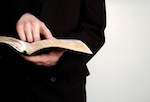 Question: What was the point of the ten plagues in Egypt? If God was so determined to set his people free, why didn’t he just do it without all the drama?
Question: What was the point of the ten plagues in Egypt? If God was so determined to set his people free, why didn’t he just do it without all the drama?
Answer: The plagues in Egypt were not intended by God only to convince Pharaoh to release the Hebrews, but also to expose the idols of Egypt as false gods.
We read of this in Exodus 12:12, “Against all the gods of Egypt I will execute judgment: I am the Lord.”
Let me show you how specific these judgments were:
The Nile River was Egypt’s most valuable natural resource, but rather than being grateful to God for it, they thanked dumb idols like Hapi, Khnum, Osiris, Neith, and Hathor (all of whom had some connection with the great river). So in the first judgment, God proved the Nile gods to be false by turning the Nile River into blood. Their fountain of life became as foul as death.
Due to the agrarian nature of their culture, the Egyptians also served fertility gods. Heqt was one such goddesses and also one the four prime evil gods. Interestingly enough, she also had the head of a frog which caused a superstitious fear of frogs. So in the second judgment, God proved the goddess of fertility to be false by calling forth the frogs.
Because of Egypt’s geography, it was also important to keep the gods of the desert and dust happy, lest they send a dust-storm. Set and Geb were these gods. So in the third judgment, God proved the gods of the desert to be false by turning the dust into lice.
The Egyptians also feared Uwachit, lord of the flies, and Amon-Ra, who had the head of a beetle. So in the fourth judgment, God proved the gods of the insects to be false by sending swarms.
Like us, the Egyptians also coveted a strong economy and in their culture livestock was wealth. Apsis was the bull god and Hathor was a fertility goddess who had a cow’s head. So in the fifth judgment, God proved the gods of livestock to be false by killing all the livestock.
Also like us, the Egyptians were obsessed with health care. Sekmet had power over disease, Sunu was the god of pestilence, and Isis offered physical healing. So in the sixth judgment, God proved the gods of health care to be false by sending boils on all the people.
Now lifting our thoughts a bit, Horus was Egypt’s sky god, Nut was the sky goddess, Shu was the wind god, Osiris guarded the crops, and Set controlled the storms. So in the seventh judgment, God proved all the sky gods to be false by sending hail mixed with fire.
Egypt’s economy was nearly crippled by these disasters, but there was some grain left in the field. However, just as they might think to thank the grain god Nepri or the fertility god Ermutet, or the great guardian of the fields Anubis, or even the chief god of the crops Osiris, the next judgment came. In the eighth judgment, God proved the agricultural gods to be false by sending the locusts to devour whatever was left after the previous plagues.
While most of the idols named in this article are unknown to our readers, there is at least one that is probably familiar to all: Ra, the god of the sun. To this idol, the Egyptians sang each morning, “Hail to thee beautiful Rah of every day! Who rises at dawn without ceasing! hail to thee!” In the ninth judgment, God proved the Sun god to be false by sending a darkness that was so thick it could be felt.
When it came time for the final judgment, things got more personal. Besides Min being the god of reproduction, Heqet being the goddess of childbirth, and Isis being the protector of children, Pharaoh himself claimed to be a god, which made his first-born the son of god. So in the tenth judgment, God proved the Egyptian gods of life and death to be false by killing all the first-born of Egypt.
Hence we see that the judgments against Egypt were not merely a means toward freeing the Hebrews, but also a mockery of every false god the Egyptians served.
The one true God sent these judgments so that they (and we) might know: He will share his glory with no other and woe be to all those who put their trust in idols.
